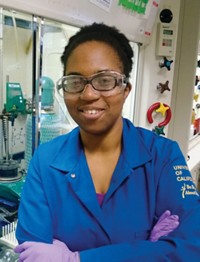Advertisement
Grab your lab coat. Let's get started
Welcome!
Welcome!
Create an account below to get 6 C&EN articles per month, receive newsletters and more - all free.
It seems this is your first time logging in online. Please enter the following information to continue.
As an ACS member you automatically get access to this site. All we need is few more details to create your reading experience.
Not you? Sign in with a different account.
Not you? Sign in with a different account.
ERROR 1
ERROR 1
ERROR 2
ERROR 2
ERROR 2
ERROR 2
ERROR 2
Password and Confirm password must match.
If you have an ACS member number, please enter it here so we can link this account to your membership. (optional)
ERROR 2
ACS values your privacy. By submitting your information, you are gaining access to C&EN and subscribing to our weekly newsletter. We use the information you provide to make your reading experience better, and we will never sell your data to third party members.
Careers
MIT's Diversity Problems
Academe: Prestigious science institution takes a long look in the mirror and doesn’t like what it sees
by Linda R. Raber
January 25, 2010
| A version of this story appeared in
Volume 88, Issue 4
Massachusetts Institute of Technology has just issued a strikingly candid department-by-department study of the racial composition of its faculty. It documents the bias and barriers that have resulted in slow progress in recruiting and retaining faculty from underrepresented minority groups.
Paula T. Hammond, professor of chemical engineering at MIT, chaired the committee that produced the 142-page “Report on the Initiative for Faculty Race and Diversity.” More than two years in the making, this painstakingly researched and documented report is available at web.mit.edu/provost/raceinitiative.
The study looked at African American, Hispanic, and Native American minorities, who make up nearly 30% of the U.S. population. Currently, 66, or 6.4%, of the 1,026 MIT faculty members come from these groups. A sampling of broad subject areas reveals that at MIT, these underrepresented minorities make up nearly 10% of 164 humanities, arts, and social sciences faculty. Seven percent of the 370-member engineering faculty is from these groups. In the sciences, only 2.8% of 282 faculty members are underrepresented minorities.
Currently, no one from these groups is on MIT’s chemistry or biology faculties, and over the past 20 years, there have been no such hires to the faculties of chemistry, nuclear science and engineering, or mathematics.
Hammond explains that one barrier to recruiting minority faculty could be addressed by enlarging the pool from which the institute recruits. “MIT recruits heavily from its own graduates and those of a few peer institutions, potentially causing it to miss outstanding minority candidates from other schools,” she says. Overall, 55% of all minority faculty members at MIT have received degrees from MIT, Harvard University, or Stanford University.
Once on the MIT faculty, minority faculty report very different workplace experiences than other colleagues and a reluctance to discuss their observations. One faculty member reports that “silence surrounding race can lead to an atmosphere where some question whether issues of race should be brought up at all.” This silence “obscures points of unequal treatment for faculty of color,” the faculty member adds.
According to Hammond, “The challenges remain high in increasing the number of faculty in the field of chemistry; we can use this moment as a chance to discuss why our academic pipeline is so challenged in this field, given the exciting developments in chemistry and the large number of chemistry departments.”
She suggests leveraging partnerships like the Future Faculty Workshop organized by MIT chemistry department Chair Timothy M. Swager, Carnegie-Mellon Dean (and chemist) Rick McCullough, and faculty from other universities “for preparing senior grad students and postdocs for the academic application process.”
“MIT chemistry doesn’t look good in this report,” Swager says, “ but we are clearly not alone in U.S. academics. Hopefully, we will be able to improve our record in the near term and this report, and what is sure to follow should help us to focus our efforts.”






Join the conversation
Contact the reporter
Submit a Letter to the Editor for publication
Engage with us on Twitter